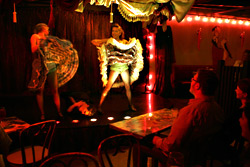Entering Can Can is like walking into Moulin Rouge. Not the Parisian tourist trap, rather the Baz Luhrmann movie, minus the upchuck-inducing camera work. I take the time to do a slow pan: The Pike Place Market cabaret that once hosted Patti Summers and her linoleum-and-patio- furniture decor has become a fantasy in burgundy crushed velvet. The bar lounge and the raised dinner area circle around a stage framed in lush swags of satin. Bartenders in black shirts and half-tucked silk ties shake cocktails doled out by well-inked waitresses in corsets and flounced skirts. Their spiritual ancestors—Toulouse-Lautrec figures with hiked knees and tuberculosis-bright cheeks—peer out from the walls. Is that Cantonese trip-hop coming from the speakers?
When the music fades, Bing Wheeler bounds in, sporting a cream lounge suit and lacquered hairdo. Bing (Kaleb Hagen-Kerr) and his wife Penelope (Erin Spencer) typically draw a capacity crowd to their Thursday night show, Big Wheel Bingo. Dozens of “dabber” markers hover over tables papered with numbered squares as the Tsunami Sisters, two vixens in black ballgowns, spin the Big Wheel for bingo numbers.
Bing Wheeler is in total command. Nothing—dodging wadded bingo cards as they fly past his face, presenting a pink ceramic poodle to one round’s winner—makes him shake the smarmy D-grade game-show host he’s playing. He even stays in character while serenading us with a jaw-droppingly soulful rendition of “Purple Rain.”
Our waitress is not quite so unfazed. My friend and I have stacked the remains of our plates to one side, since she has been too overwhelmed by the action to clear the table. The fries ($6) are all gone. (Can you leave fries on the plate? I can’t.) Perfectly crisp, they’re dusted with fennel salt and finely shaved parmesan, and after a swirl through an acidic yet otherwise unseasoned dill sauce, I prefer them straight up. The fat pappardelle noodles ($18) tangled around sauteed mushrooms in a truffled cream sauce are also cooked just right.
However, the rest of the food, from the overcooked scallops ($12) served with undercooked cauliflower in a chunky marinara sauce to a spinach salad ($6) whose sugar-sweet vinaigrette wages a take-no-prisoners war with the pancetta and goat cheese scattered over top, is enthusiastically conceived and short on finesse. But we’re having a good time, trying to decide whether we do or don’t desperately want to win one of the prizes. When the check comes, I raise my eyebrows at the amount but pay out. Then we leave. As I sober up, I come to my senses: $120 for four mediocre appetizers, two rounds of drinks, and two $10 cover fees? WTF?
Can Can is open six nights a week, serving food and drinks before, during, and after its two nightly shows. Some performers, like Bing and Penelope, are outside acts, while the cancan dancers who appear most nights double as waitresses. When I talk to cabaret owner Chris Snell, he says that the kitchen is run by his sister and brother, Carmen and Jeff Malloy, who oversee the menu from Boston, where they own the acclaimed restaurant Carmen. Just before publication, the Can Can is unfortunately short a lead cook, which would explain why the food sounds much better than it tastes.
Years of attending dinner theater have left me with low expectations, so a week earlier, I walked out of Can Can feeling that my (well, the paper’s) money had been well spent. No cover charge this time. Instead, our night with the Tableau Vivant burlesque troupe came free with a three-course prix-fixe dinner ($35). While we waited for the show to begin, we sipped fine renditions of standard cocktails—a Sazerac for the gentleman and a French martini for the lady—that were better than the clumsily executed herb-and-fruit concoctions I tasted on my second time around.
Tableau Vivant danced and mimed skits involving dueling courtesans in Louis XIV–era dresses and mechanical dolls launching failed love affairs. An appropriately gravel-voiced Danny Dead spun tales and the Bad Things Orchestra accompanied the action with Parisian circus-slash-jug band music. It was burlesque in its broadest sense: light on salaciousness and heavy on broad humor, with titillation for everyone present—buxom women jiggling their pasties and the only man who’s ever made a skintight red knit leotard look alluring. Lights shining up from the stage floor cast the performers’ beauty in tawdry, exotic hues, making them look like they belonged in the Moulin Rouge—this time the Parisian icon, not the movie.
On that first night, the food was simple and nicely seasoned. To begin, plump prawns were sauteed in a not-too-pungent garlic butter, and a mixed-greens salad was fresh and dressed with more restraint than the performers. Our second course, a medium-rare filet mignon, showed up medium-rare, with garlic mashed potatoes that were only slightly gummy. No cook shows himself at his best when he serves 40 people all at once, so I wasn’t overly surprised when my halibut with lemon risotto arrived long after my companions had cut into their steaks; the fish was tasty and lukewarm, the risotto nicely al dente but congealed. We finished the meal with lemon sorbet and a beautifully creamy chocolate mousse.
The experience cost us half of what a night at Teatro ZinZanni would, and left me reasonably content. But it was thanks to the massive wine pours and the atmosphere more than anything I ate—and you can soak up the atmosphere without shedding the bucks. If you’re ready to delve into the surreal swirl of Can Can, take note: The view from the bar lounge isn’t bad.






